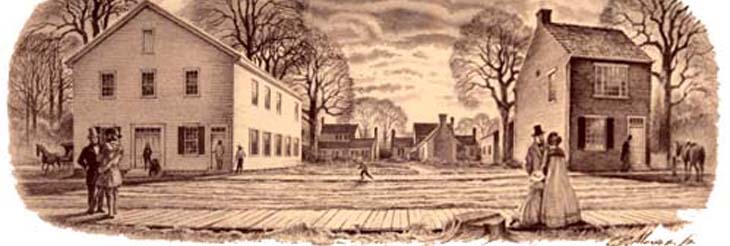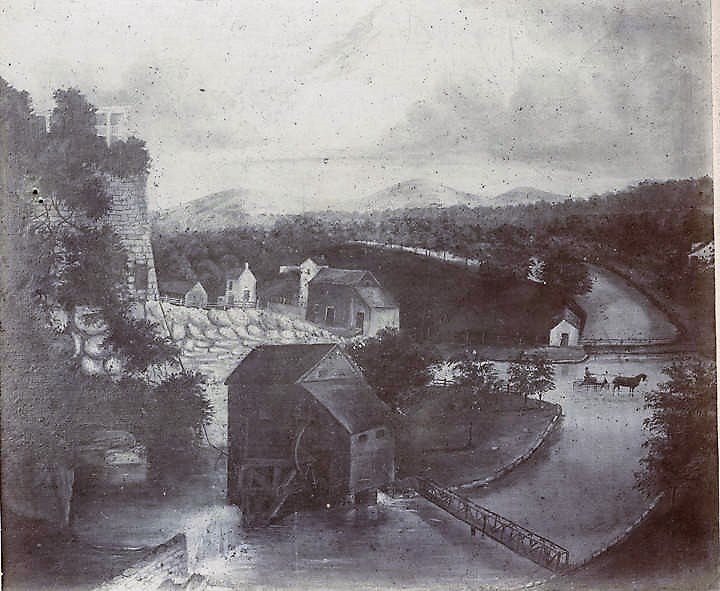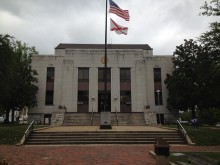On August 2, 1819 – The first Constitution of Alabama was adopted paving the way to statehood in December. It was considered a model of democracy at the time because if granted suffrage to all adult white males without regard to property ownership or other qualifications.
Held in Huntsville
In keeping with the provisions of the Congressional Enabling Act, of March 2, 1819, elections for forty-four delegates to a Constitutional Convention were held in May, and those elected convened at Huntsville, July 5th.
 Old Huntsville (Alabama Department Archives and History)
Old Huntsville (Alabama Department Archives and History)
The following are some excerpts from legislature.state.al.us
The composition of the Constitutional Convention of 1819 (July 5 – August 2) was remarkable, considering the brevity of Alabama’s life as a Territory, and the overall frontier character of those portions under jurisdiction of the United States. In his comprehensive work, Constitutional Development in Alabama, 1798-1901, Dr. Malcolm McMillan offers some insight into the delegates who framed Alabama’s first Constitution:
| “Forty-four delegates were elected to the convention which assembled in Huntsville on July 5, 1819. Of this number there were at least eighteen lawyers, four physicians, two ministers, one surveyor, one merchant, and four planters or farmers…Nine of the forty-four had had prior legislative or judicial experience in the states from which they had come. Harry Toulmin of Baldwin County had been president of Transylvania University, Secretary of State for Kentucky, and an Alabama territorial judge since 1804. William Rufus King of Dallas County had served in Congress from North Carolina from 1810 to 1816 and after that was Secretary of the American Legation to St. Petersburg, Russia…Israel Pickens from Washington County had been a member of the North Carolina Senate and had represented that state in Congress from 1811 to 1817. Marmaduke Williams of Tuscaloosa County had been a member of the North Carolina Senate and had served that state in Congress from 1803 until 1817. John Leigh Townes had served in the Virginia legislature in 1815 and 1816. John Murphy of Monroe had been clerk of the South Carolina Senate for ten years and a trustee of South Carolina College, 1809-1818. Clement Comer Clay, Henry Hitchcock, Hugh McVay, James McGoffin, Gabriel Moore, Reuben Saffold, and John W. Walker had all been members of the Alabama territorial legislature and Samuel Garrow, Mayor of Mobile. At least eight of the men had had some college training. The potential ability of the delegates is best indicated by the fact that from them the state obtained six governors, six judges of the supreme court, and six United States senators.” |
The Alabama State Constitution (Oxford Commentaries on the State Constitutions of the United States) 1st edition by Stewart, William H. (2011) Hardcover
 Painting of Big Spring and water works in Huntsville ca. 1850 by Laura Bassett (Alabama Department of Archives and History
Painting of Big Spring and water works in Huntsville ca. 1850 by Laura Bassett (Alabama Department of Archives and History
As Dr. McMillan states in Constitutional Development:
| “The Alabama Constitution of 1819 was definitely a mixture of liberalism and conservatism, the product of the past as well as a forerunner of the future. It was liberal in several particulars. There were no property, tax-paying, or militia qualifications for voting or for office holding. The people were given participation in the amending process…The governor was made elective by the people instead of being elected by the legislature as in the old states, and sheriffs were made elective by the people instead of being appointed by the county court. The clerks of court were made elective by the people. Liberal clauses were included protecting the rights of slaves. On the other hand, the document was basically conservative, when judged by the standards of frontier democracy a decade later. One of the tenets of this democracy was the election by the people of all their public officials. In Alabama the people could elect the executive, the legislature, the sheriffs, and clerks of court, but all other officials were appointed by joint vote of the legislature. Under the Constitution of 1819, once the people elected the legislature, government passed to a great extent into the hands of that body.” |
Constitution was adopted on August 2nd, 1819
On August 2nd, the Convention formally adopted the Constitution, then adjourned. The Constitution, thus, was considered ratified and operable as of that date. The Congressional Enabling Act did not specify submission of the Constitution to the people for ratification, nor was it the custom of the day for new states to do so.
Read more stories about early Alabama in ALABAMA FOOTPRINTS: Statehood –
Some stories include:
- Who Controlled And Organized The New State of Alabama?
- Tuscaloosa Had Three Other Names
- Chandelier Falls & Capitol Burns
- Alabama Throws Parties For General LaFayette
- Francis Scott Key Was Sent to Alabama To Solve Problems




